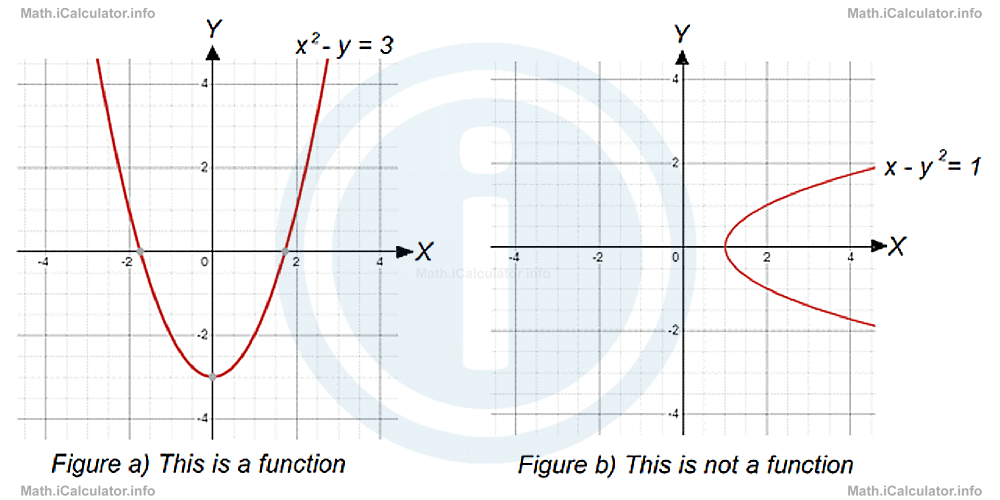Menu
Math Lesson 13.3.1 - A Brief Introduction to Functions
Please provide a rating, it takes seconds and helps us to keep this resource free for all to use
Welcome to our Math lesson on A Brief Introduction to Functions, this is the first lesson of our suite of math lessons covering the topic of Modelling Curves using Logarithms, you can find links to the other lessons within this tutorial and access additional Math learning resources below this lesson.
A Brief Introduction to Functions
Before continuing with exponential graphs, first, we have to anticipate the definition of a function in mathematics. (We will deal with this concept more extensively in chapter 16 of this course). A function is a one-to-one relationship between each term of the independent variables set (usually denoted by x) to the corresponding terms of the dependent variables set (usually denoted by y). This one-to-one relationship is often given by a formula but in many cases, it is shown graphically through the graph's line.
It is worth stressing here that an element of the dependent variables set may two or more different values have in correspondence from the independent variables' set and this relationship is still a function, but the reverse is not allowed in functions. In simpler words, a y-value may have two or more x-values in correspondence (for example, in the function y = x2, where the value y = 9 has two x-values in correspondence: x = -3 and x = 3), but the reverse cannot happen, or if this happens, that kind of relationship between the x- and y-values is not a function. For example, y2 = x - 1 is not a function, as for a single x-value (for example x = 5) we obtain two corresponding y-values (y = -2 and x = 2). The equations discussed in chapter 9 may or may not represent functions, depending on the type of correspondence their variables have.
The graph of a function shows the line that contains all the possible combinations between the x-values and the corresponding y-values of that function. Depending on the formula of the function, the graph may be a straight line (in linear functions), a parabola (in quadratic functions, a hyperbola (in the inverse functions, i.e. in functions of the form y = k/x) and so on. Exponential and logarithmic functions have their corresponding graphs too, which we will discuss later on this tutorial.
A good method to check whether a given graph represents a function or not is to draw a vertical line in the sections where you have doubts that an x-value may have two or more y-values in correspondence. If the vertical line intercepts the graph at more than one point, that graph does not represent a function. Look at the figure below, where the graphs of the lines (equations) x2 - y = 3 and x - y2 = 1 are shown.

Figure (a) which represents the line x2 - y = 3 shows a function, as all values of the independent variable set (x-values) have a single y-value (dependent variable) in correspondence. This is easy to confirm, as if you draw a vertical line from any position, it will intercept the graph at one point at maximum.
On the other hand, figure (b), which represents the line x - y2 = 1 does not show a function, as you can easily find x-values that have two y-values in correspondence by drawing vertical lines. Thus, if you draw the vertical line x = 2, it will intercept the graph in two points with y-coordinates y = -1 and y = 1 respectively.
We denote a function by y(x), f(x), etc., but in this tutorial, we will use the first notation, for example, y(x) = 3x - 1, y(x) = x2 - 2x + 7, etc. The variable in brackets shows the independent variable. We read the notation y(x) as "the set of dependent variables y that are in function of the corresponding independent variables x."
More Modelling Curves using Logarithms Lessons and Learning Resources
Whats next?
Enjoy the "A Brief Introduction to Functions" math lesson? People who liked the "Modelling Curves using Logarithms lesson found the following resources useful:
- Introduction Feedback. Helps other - Leave a rating for this introduction (see below)
- Logarithms Math tutorial: Modelling Curves using Logarithms. Read the Modelling Curves using Logarithms math tutorial and build your math knowledge of Logarithms
- Logarithms Video tutorial: Modelling Curves using Logarithms. Watch or listen to the Modelling Curves using Logarithms video tutorial, a useful way to help you revise when travelling to and from school/college
- Logarithms Revision Notes: Modelling Curves using Logarithms. Print the notes so you can revise the key points covered in the math tutorial for Modelling Curves using Logarithms
- Logarithms Practice Questions: Modelling Curves using Logarithms. Test and improve your knowledge of Modelling Curves using Logarithms with example questins and answers
- Check your calculations for Logarithms questions with our excellent Logarithms calculators which contain full equations and calculations clearly displayed line by line. See the Logarithms Calculators by iCalculator™ below.
- Continuing learning logarithms - read our next math tutorial: Natural Logarithm Function and Its Graph
Help others Learning Math just like you
Please provide a rating, it takes seconds and helps us to keep this resource free for all to use
We hope you found this Math tutorial "Modelling Curves using Logarithms" useful. If you did it would be great if you could spare the time to rate this math tutorial (simply click on the number of stars that match your assessment of this math learning aide) and/or share on social media, this helps us identify popular tutorials and calculators and expand our free learning resources to support our users around the world have free access to expand their knowledge of math and other disciplines.